Eye Muscle Scanning
Eye Muscle Scanning
You can make a online booking or contact us to arrange your booking.
The highest boned out yield of red meat in lamb competitions in N.Z. of unscanned breeding is a yield of 53%. The highest boned out yield of red meat from scanned breeding in a lamb competition in N.Z. is now 57%. The highest yield in the U.K. from scanned breeding is now 61%.
It is a known fact that it takes more energy for a sheep to make 1kg of fat than it does to make 1 kg of red meat. So as long as a fatter type of lamb is eating exactly the same amount as a leaner type of lamb then it will be unable to grow as fast.
Ultrasound scanning has the potential to bring about a dramatic improvement in our sheep if used correctly.
Ultrasound scanning gives ram buyers the opportunity to see just how well muscled a particular animal is and just how fat that animal is, very quickly and without harming the animal.
What is measured?
The width of the eye muscle is called measurement A, the depth of the eye muscle is measurement B, the depth of fat between the eye muscle and the skin is measurement C and if the operator shifts the scanner to the G.R. site 11cm from the backbone the G.R. fat depth can also be taken.
A cross-section of a sheep carcass at the 12th rib and a schematic drawing showing the location of the various ultrasonic measurements
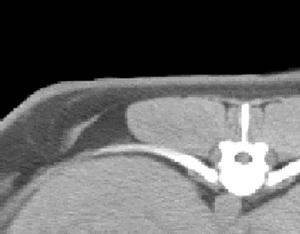 |
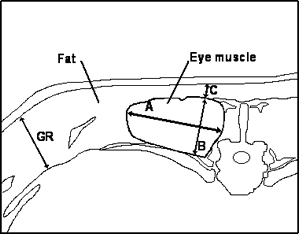 |
Why use Ultrasound Scanning?
Ruakura researchers Neil Clarke, Bruce Binnie and Alan Kirton have proved in work carried out at the Waitotara Meat processing Plant that eye muscle area is a definite indicator to total meat yield. Scanning allows a ram breeder to fully evaluate sires and their progeny without having to slaughter any of the progeny to carry out the evaluation. Because both eye muscle area, and fat depth are about as heritable as growth rate, very significant gains can be made if scanning data is used.
More emphasis should be directed at our dual purpose breeds as the terminal sire breeds are sires of less than 20% of lambs. The potential to improve technology which allows direct measurement, is obvious.
If we assume 20% of the lambs are produced as a result of mating to terminal sire breeds (in this example I include the Texel in this Category) then the number of lambs which are sent to the meat processing plants are as follows:
Assumptions
- 2000 ewe flock
- 110% lambing
- all sold to slaughter except 600 replacement ewe lambs
- 100 replacement ewe lambs culled as hoggets
- 20% of ewes to terminal sire (80% to "Own Breed")
|
400 ewes mated to terminal sires, all lambs sent to meat processing plants |
440 lambs |
|
Half the lambs are males and go to the meat processing plants |
880 lambs |
Thus in this example there are 440 lambs sired by the terminal sires, and 1260 animals which are derived from "Own Breed" sires, i.e. almost three times as many animals are of "Own Breed" origin.
Consequently it is very clear that there is a very big opportunity of added emphasis in selection of superior breeding stock on the basis of muscle and fat scanning in "Own Breed".
Using ultrasonic fat and muscle measurements to select genetically superior animals is estimated to more than double the financial return compared to using live weight alone in meat breeds.
Meat Yield Scanning
A Guide to Improving Meat Yields through Ultrasound Scanning of Commercial Ewes and Rams
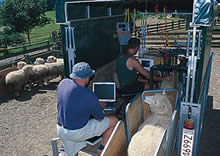
Why Scan
Scanning for performance traits in animals has become a significant on-farm tool over the last 10 years within the stud industry. Now, Stockscan's technology can assist you to accurately identify flock performance animals in many different ways.
By identification through scanning on-farm for conformation of superior flock ewes and better performing flock rams you will:
- Increase your returns on terminal lambs and replacement ewe lambs
- Correctly identify replacement ewes based on known conformation data
- Obtain economic gains through higher meat productivity per hectare of grass
- Selectively combine known productive traits of both ram and ewe, by measuring their progeny through scanning.
What and When to Scan
Hogget and 2th Replacement Ewes
- Hogget and 2th's should be selected for ultrasound scanning for meat yield. This will provide financial and productivity gains on future replacements
- Early scanning will give the best returns over the life of the ewe
- The referred time for scanning Hoggets and 2th's is October through to mating.
Flock Rams
- At the initial stage of scanning, all flock rams should be included in your scanning programme
- Scanning all flocks should be done prior to mating when rams are in a forward condition
- After scanning, rams can then be identified for desirable traits and matched with selected ewes
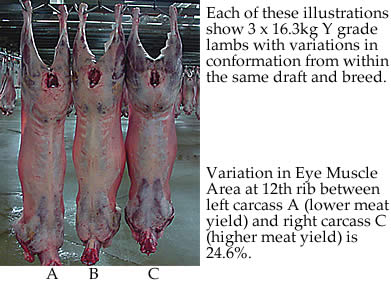
Q Which breeds yield the best muscle area?
A All breeds have the ability to provide premium payments for higher meat yield through EMA scanning and selection.
Q Do bigger animals give better eye muscle?
A No. Only through EMA scans and identifying conformation can you be sure of optimal animal efficiency
Q If I scan my ewes should I scan my flock rams?
A By scanning ewes and rams you can identify the essential traits from dams and sires required to produce higher meat yielding progeny.
Q I already have a good ewe flock so why should I scan?
A In the best flocks, there will be a mix of better and poorer producing stock.Scanning will eliminate poorer stock that do not fit the optimal requirements of the end market. There is always room for improvement in quality and profit per stock unit.
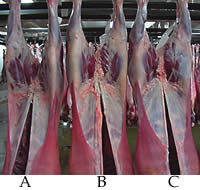 |
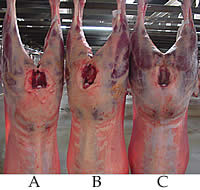 |
In each illustration:
Left carcass A: lower meat yielding lamb
Middle carcass B: average meat yielding lamb
Right carcass C: higher meat yielding lamb
Better Returns - The Facts
Some meat producers are rewarding farmer suppliers for meat productivity and quality relative to the markets of their overseas customers.
The rewards are benefiting producers of quality carcasses in the following ways:
- Up to 15% better return for a higher meat yielding market choice lamb based on a 16 Kg Y lamb carcass.
- Improved overall carcass yields from 54% within a Y grade flock of draft lambs by scanning selection of superior ewes and performance rams. This equates to 17% higher meat production.
- Achieving optimal meat yield in terminal lambs results in earlier drafting options.
- The biggest, leggiest lambs do not necessarily produce the best returns per kg of carcass weight.
- Eye muscle areas can vary by up to 30% within a flock breed prior to scanning selection.
- All breeds have the ability through scanning selectivity to produce higher yielding progeny with no extra feeding cost in feeding.
- Rams should be scanned to select desirable traits for mating with required traits in replacement ewes.